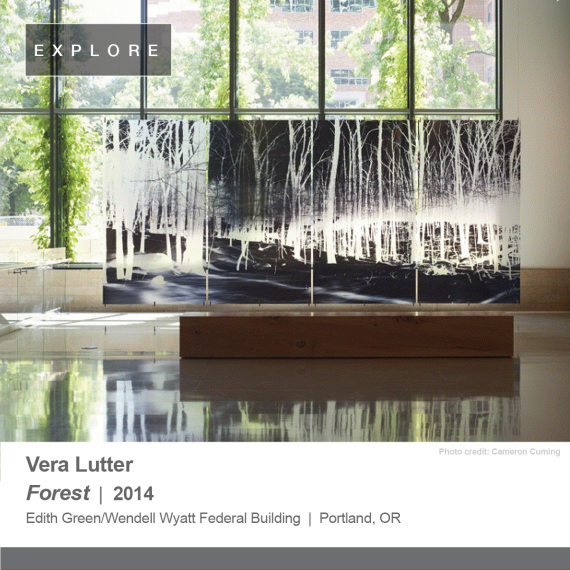GSA Celebrates 50 Years of the Art in Architecture Program
by Cynthia Henry
This month marks the 50th Anniversary of GSA’s Art in Architecture Program. The program is part of the Center for Fine Arts in the U.S. General Services Administration Public Buildings Service. The Center for Fine Arts is responsible for the commissioning and care of all artworks in the GSA’s Fine Arts Collection.
Congress allocates funds to GSA for the construction of new federal buildings, which includes a small percentage for art. GSA reserves 0.5% of the estimated construction cost of each new federal building or modernization for an AiA commission — a contractual agreement with an artist to create a site-specific artwork as part of the building project.
GSA has commissioned American artists who are citizens or lawful permanent residents of the United States to create artworks for federal buildings across the United States including:
- Federal agency headquarters
- Federal buildings
- U.S. Courthouses
- U.S. Land Ports of Entry (border stations)
Since 1972, the AiA program has commissioned more than 500 artworks permanently installed in buildings across the country. There are currently 46 AiA artworks installed in buildings across Region 10.

From its beginning, the AiA program has not endorsed an official style of art, any particular medium, or content. The artist’s work takes into account the design of the building and its location. The vast majority of artwork in Region 10 are sculptures however various art forms are represented.
The first AiA commissioned artwork in Region 10 was installed outside the Federal Building and U.S. Courthouse in Eugene, Oregon on August 7, 1975.
“Trapezoid E” is a painted aluminum sculpture created by Northwest artist Robert Maki. The abstract work measures 144 x 180 x 120 in. and weighs 3500 lbs.
According to the Washington State Arts Commission, Robert Maki creates minimalist abstract sculptures that provide precise angles and sight lines that are important to the viewer’s experience and the overall design. The direction of the sun, time of day, and weather conditions are often important factors in Maki’s sculptures because they affect how the viewer sees the artworks.
The most recently commissioned artwork in Region 10 was in 2014. Vera Lutter created “Forest” for the interior space of the Edith Green/Wendell Wyatt Federal Building in Portland, Washington.
The architectural transformation of the Edith Green/Wendell Wyatt Federal Building, completed in 2013, inspired artist Vera Lutter to create Forest, a translucent screen of four acrylic panels printed with an image of an ethereal woodland.
To capture this photographic image, Lutter used a camera obscura (Latin for “dark room”), an optical device first developed during the 17th century to project an image inside a camera through a pinhole aperture. Lutter used a room-sized camera obscura on-site in the forest to expose an image of the adjacent landscape onto a large sheet of silver gelatin paper, producing a photographic negative that she later developed in a traditional darkroom. Lutter then used a digital camera to re-photograph the developed image. This transfer of the image from analog to digital format allowed Lutter to heighten tonal contrasts and print the resulting high-definition image onto the acrylic panels. The piece measures 100 x 227 x ¼ in.
As installed in the federal building, Forest is both a photographic and a sculptural artwork that physically engages viewers, the architectural space, and the always-changing natural light that filters through the nearby windows. By using a photographic negative, which reverses areas of light and dark, Lutter has made a familiar scene appear unfamiliar: the bright sky and snow-covered ground are rendered black, whereas the dark tree trunks and shadowy horizon glow white. According to Lutter, her art is not about making realistic images, but rather about the passage of time, such as the time it took trees to grow and the snow to fall, and the duration of her camera’s exposure to capture the image.
There will be more opportunities for artists to create and the public to experience artworks. The 2022 Bipartisan Infrastructure Law (BIL) includes funding to enable the modernization and expansion of 26 major construction and modernization projects at land ports of entry (LPOE) including several in Region 10:
- Alcan LPOE | Tok, Alaska
- Porthill LPOE | Porthill, Idaho
- Pacific Highway LPOE | Blaine, Washington
- Sumas LPOE | Sumas, Washington
- Lynden LPOE | Lynden, Washington
Learn more about the AiA program:
- Blog: GSA Celebrates 50 Years of Art in Architecture
- Campaign website: AiA 50
- Gallery: Celebrating 50 Years of Art in Architecture: 1972–2022
- National Artist Registry

 U.S. General Services Administration
U.S. General Services Administration

